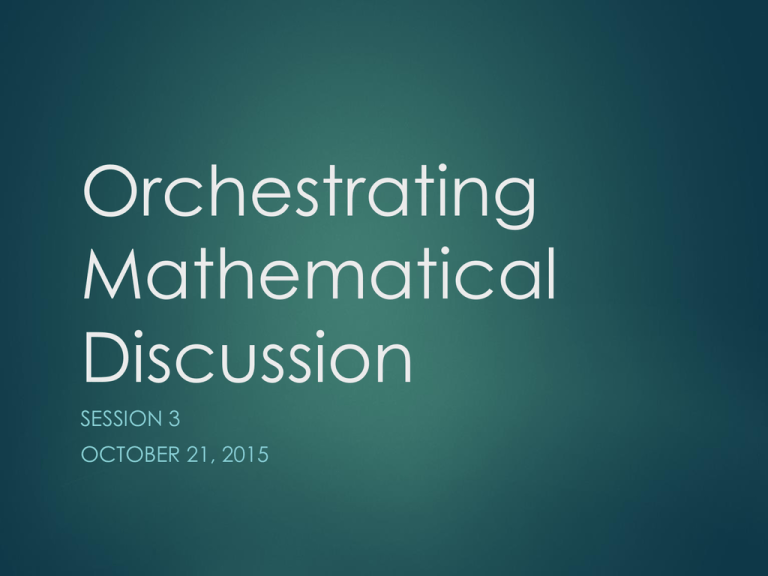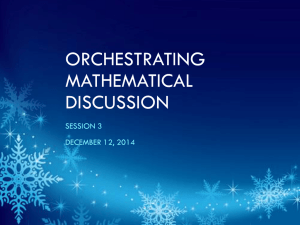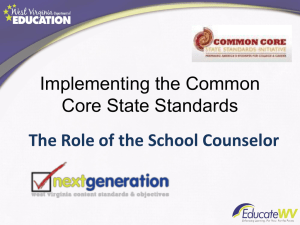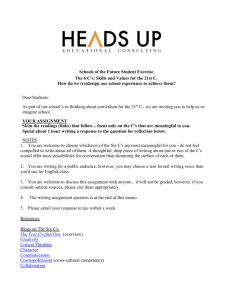Orchestrating Mathematical Discussion SESSION 3
advertisement

Orchestrating Mathematical Discussion SESSION 3 OCTOBER 21, 2015 Overview Lesson Sharing Connecting Discussion Problem Solving LUNCH SAT Globe Activity Rigor Discussion Paperwork We need: SCECH Forms Substitute Reimbursement Form Share Protocol Describe the strategy and implementation (3 minutes) Group asks clarifying questions and presenting teacher may respond (2 minutes) Provide (2 minutes) Reflect (1 warm and cool feedback based on feedback minutes) Reflection What was the most meaningful/beneficial thing your group learned from this experience? Would you use this with students? If so, how would you adjust the questions? Connecting Discussion 5th Practice for Orchestrating Mathematical Discussions Most Challenging Dependent on questioning to reveal student thinking Link between mathematical ideas and representations to critically consider a mathematical concept. Connecting UNIT Sequence Topics and Build Connections Intradisciplinary Interdisciplinary Lesson Sequence Connecting 5 Practices Rubric Review the 5 Practices Rubric In your group, please discuss the following: Strengths and weaknesses of the rubric Uses of the rubric 5 Practices Rubric Use your rubric to rate the following classroom After the clip is done, discuss with your ratings and logic behind the ratings BREAK Candy problem solving Work in groups to solve your assigned method Fraction Percent Ratio (Unit Rate) Ratio (Scaling Up) Additive ** When ready, place your solution method on a poster paper Candy problem solving Selecting, Sequencing, and Connecting How would you select and sequence? Would you use them all? Why or why not? lunch SAT SAT Research Current research shows that three key areas most contribute to readiness for college and career training: Heart of Algebra (mastery of linear equations) Problem Solving and Data Analysis (quantitative literacy) Passport to Advanced Math (familiarity with more complex equations) SAT Math The overall aim of the SAT Math Test is to assess fluency with, understanding of, and ability to apply the mathematical concepts that are most strongly prerequisite for and useful across a wide range of college majors and careers. The Math Test has two portions: Calculator Portion (38 questions) 55 minutes No-Calculator Portion (20 questions) 25 minutes Total Questions on the Math Test: 58 questions Multiple Choice (45 questions) Student-Produced Response (13 questions) SAT Math Topic Areas Heart of Algebra Linear equations Fluency Problem Solving and Data Analysis Ratios, rates, proportions Interpreting and synthesizing data Passport to Advanced Math Quadratic, exponential functions Procedural skill and fluency Additional Topics in Math Essential geometric and trigonometric concepts SAT Practice Try on your own. SAT Practice Use the student work provided as if it is your own classroom. What would you do to address your class and their needs? SAT Practice Please take some time to go online and look at the various resources available. www.gvsu.edu/s/Jk Globe activity Use the first sheet to make a quick, independent estimation. Globe activity Please take the next 15 – 20 minutes to solve the problem in as many ways as you can find. Please feel free to work with your peers. Thought Provokers by Doug Rohrer, published by Key Curriculum Press ($3) Circling the Earth BY MIKAYLA AND AUDREY A. PLEASE NOTE That the following presentation is given under the assumption that the earth is perfectly spherical. A Visual Representation The Earth The circumference of the Earth and the Earth’s circumference with the thread. The radius of the Earth and the Earth’s radius with the thread. A Birds Eye View / Let Statements Let r1 be the radius of the earth Let r2 be the radius of the earth with the 100 extra feet of string accounted for EARTH Let c be the circumference of the earth Let c + 100 be the circumference of the earth with the 100 extra feet of string. Some Simple Formulas To solve this problem, one needs to know ONLY this formula: c = 2πr circumference = (2) (π) (radius) And the Computation Begins... gap = r2 - r1 gap = c + 100 - c 2π 2π gap = c + 100 - c 2π 2π 2π gap = 100 = 50 2π π C = 2πr r1 = c/2π r2 = c + 100 2π The following slide tests our predicted conclusion c + 100 - c 2π 2π Proposed value for c c + 100 2π c 2π 30 20.69014260 4.77648293 15.915494307 250 55.6281864 39.7887357 15.91549438 1,192 205.6281864 189.7126921 15. 9154943 (solution) THANK YOU FOR VIEWING OUR PRESENTATION! break Understanding rigor Definition of Rigor as related to the Mathematics Classroom Frayer Model Individually, complete the Frayer Definition Model for the word “rigor” Once completed, discuss your definition with an elbow partner Defining Mathematical Rigor Two aspects of mathematical rigor CONTENT: Mathematical rigor is the depth of interconnecting concepts and the breadth of supporting skills students are expected to know and understand. INSTRUCTION: Mathematical rigor is the effective, ongoing interaction between teacher instruction and student reasoning and thinking about concepts, skills, and challenging tasks that results in a conscious connected, and transferable body of valuable knowledge for every student. DEFINING Mathematical Rigor As a table group, discuss your definitions of rigor with the definitions presented by Hull, Balka, and Harbin-Miles. Where do you agree? Disagree? (Be prepared to share one or two thoughts with the whole group) Rigor expectations “shift” Mathematical rigor requires a shift in beliefs and actions. In the column in the middle of the chart below, rate where you and/or your students are in thinking related to the shifts required for increased rigor in the classroom. Items in the “Current Tendencies” column would be rated “1”; items in “Future Opportunities” would be a “5”. Once you are done rating each item, select one or two to discuss with a partner or trio. evaluation Please complete the Evaluation THANK YOU!


